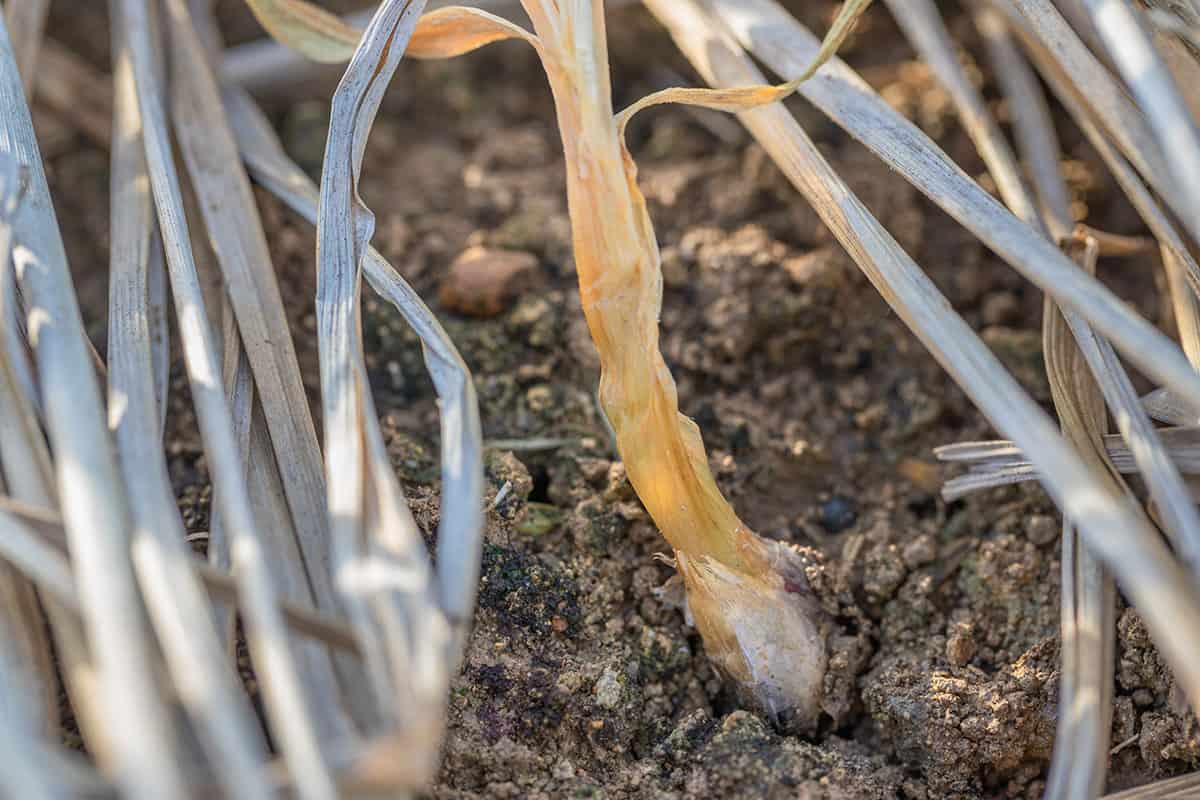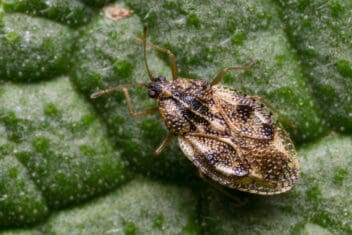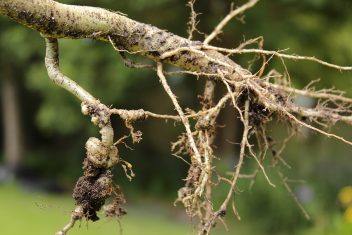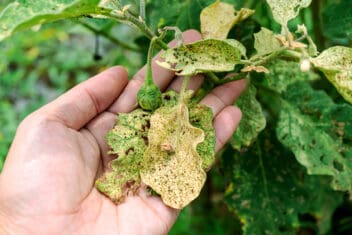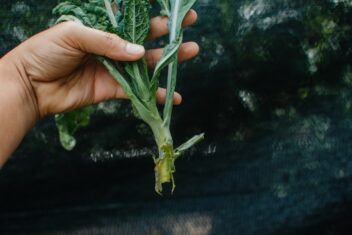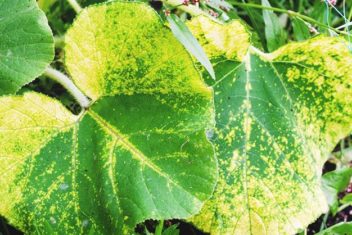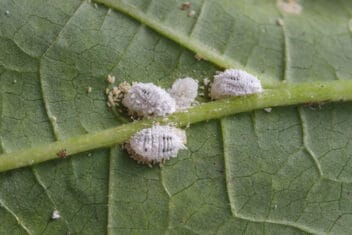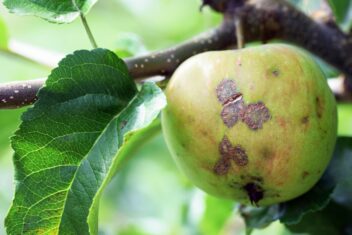Since garlic is a stinky plant, it’s easy to assume that it doesn’t have any pests and diseases that attack it, but that’s wrong.
Garlic is often used in the garden as a pest deterrent when planted as a companion plant. But some pests think that garlic is yummy and seem to be immune to the pungent scent – or even like it. Diseases, including fungal diseases, also love garlic plants.
Let’s take a look at some pests and diseases that you need to know when you grow garlic in your garden.
5 Garlic Plants Pests
Although many insects will avoid garlic like the plague, a few can’t wait to tuck in. Here are the most common garlic pests.
1. Bulb Mites
Bulb mites are one of the most common garlic plant pests that you’ll encounter. They cause stunted plant growth, and the bulbs rot in the ground or in storage. Bulb mites are tiny, measuring less than one millimeter in length; some people say they look like tiny pearls on legs.
Not only do bulb mites cause problems, but the damage they cause leaves the plants open to secondary invasions by other pathogens. Letting garden beds lay fallow helps to reduce the mite population, and you can try treating garlic seed cloves with hot water before planting.
2. Leafminers
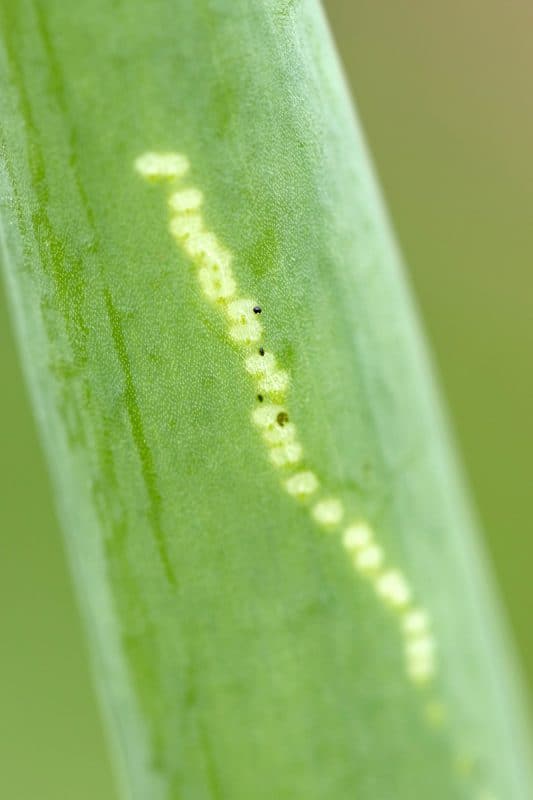
Leafminers cause thin, winding trails on the leaves, and heavy damage leaves white blotches behind. The leaves might drop from the plant prematurely.
Adult leafminers look like a small, black and yellow fly, and they lay eggs on the leaves. Then, the larvae hatch and start to feed on the interior of the leaves. Over time, the mature larvae drop from the plant into the soil to pupate. It takes between two weeks for leafminers to complete their life cycle, and these pests can produce up to 10 generations per year.
If you think you have leafminer damage in your garden, take a look at our guide to leafminers and how to control them in your garden.
3. Lesion Nematode
Nematodes are one of the most difficult pests to deal with in your garden. They cause stunted growth and round or irregular lesions on the roots. These pests have a wide range of hosts, and they enter your plant through the roots.
Unfortunately, there aren’t too many ways to get rid of lesion nematodes in the garden. Treating your garlic bulbs in hot water can help to control them, but that’s the only option you have. Crop rotation isn’t even effective.
To treat bulbs, cook them in 100°F water for 30 minutes. Don’t let the water get too hot or the bulbs won’t germinate.
4. Onion Maggots
Onion maggots are a frustrating pest that infests garlic plants, causing stunted or wilting seedlings. The plants often break at the soil line if you try to pull them out of the ground. The bulbs are typically deformed and susceptible to storage damage.
One of the problems with onion maggots is that females can lay several hundreds of eggs with a two to four-week lifespan, and insects overwinter as pupae in the soil.
A big part of managing onion maggots is to practice good sanitation in your garden. Make sure you always remove all the onion bulbs in your garden at the end of the season because onion maggots will use them as a food source. Granular insecticides can be applied to the soil to take care of these pests.
Another good idea is to put floating row covers to protect your plants in the early spring. That helps to stop the females from laying eggs on your garlic plants.
5. Thrips
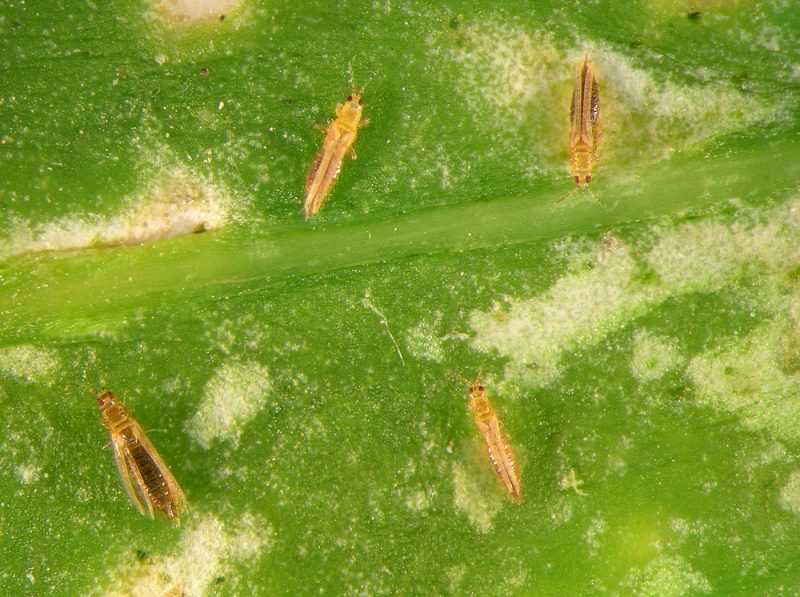
Two different types of thrips will infect your garlic plants: onion thrips and western flower thrips. Both of these pests cause discolored, distorted tissue and the scarring of the leaves. If thrips cause a severe infestation, you might notice a silvery appearance on your plant.
Thrips are small, measuring around 1.5 mm long, and hard to view with your naked eye. The adults are yellow to light brown, while the nymphs are small and lighter in color.
Releasing natural enemies into your garden is one way to control the thrips on your garlic plants. Try releasing predatory mites, pirate bugs, or lacewings into your garden. Then, read our guide on thrips in the garden.
6 Garlic Plants Diseases
While the list of diseases that infect garlic plants isn’t long, gardeners still need to know that these plants aren’t immune. Keep an eye out for these diseases, which can wipe out your garlic.
1. Botrytis Neck Rot
Botrytis neck rot causes major loss in garlic plants. In spring or early summer, you might notice water-soaked neck rot at the soil line and, over time, the fungus grows down to the bulb and starts to attack the inner axis.
When you cure the garlic, the outer wrappers will show deterioration, and the inner wrappers will turn brown or black. This fungus lives in almost all soils and some weather leads to an increase, especially cool and wet conditions.
If you end up with botrytis neck rot in your garden, you need to remove the diseased plants. In the future, make sure you have plenty of air circulation between your plants. You also can use preventative measures like avoiding too much mulch and irrigation, but getting rid of the disease is nearly impossible.
Don’t plant garlic where you’ve had it in the past.
2. Downy Mildew
Downy mildew is a common fungal disease that infects all kinds of plants, including garlic. It causes pale spots or elongated patches on the leaves of the plant, and you’ll eventually see gray-purple fuzzy growth over the leaf surface. As time goes on, the tips of the leaves die off.
Downy mildew is most common when the leaves are wet when the temperatures are cool. Appropriate fungicides can take care of this disease. Take a look at our guide to downy mildew in the garden.
3. Garlic Mosaic Virus
Just like humans can, plants can contract viruses. Garlic mosaic virus causes mosaic patterns on the leaves or you might see mottling or streaks. It also causes stunted plant growth and reduced bulb size.
Garlic mosaic virus is transmitted by aphids, and at times, the virus causes no symptoms in your plants. Since it’s a viral disease, there is no treatment. All you can do is plant virus-free garlic cloves and control the aphid population in your garlic.
4. Purple Blotch
Purple blotch is another common fungus that infects garlic plants. One of the first symptoms you’ll notice is small, water-soaked lesions on the leaves or stalks. Over time, those lesions enlarge and turn brown or purple. The lesions might join together and kill the tissue.
Purple botch emerges on wet foliage when the humidity levels at high at night. Crop rotation is one way to prevent the development of this fungal infection, as well as ensuring that soil has proper drainage. Some fungicides control this disease, but you should rotate the types of fungicides you use for optimal control.
5. Rust
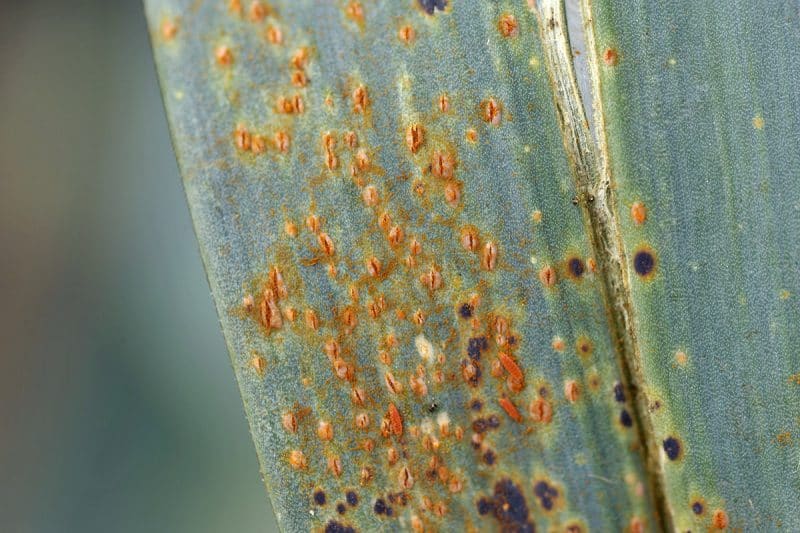
With rust, you might notice small, white flecks on the leaves and stems that develop into a circular or elongated pustule. If rust becomes a serious problem, it will cause the entire garlic plant to die.
Some appropriate protective fungicides can be used to help with rust. Learn more about rust on your plants.
6. White Rot

White or sclerotium rot is a fungal disease that causes the older leaves on your garlic plants to yellow first. It also leads to stunted growth, and over time, all the leaves will die. You’ll find fluffy white growth on the base of the bulbs.
White rot is a serious problem; it makes the area unusable for garlic production for years. It lives in the soil for up to 20 years, and white rot is highly damaging to all allium crops.
Unfortunately, fungicidal treatments aren’t always effective at treating white rot. Using long-term crop rotation helps, and you can use appropriate fungicides if available. Control typically relies on cultural methods and using effective gardening techniques.
That means buying certified clean bulbs and/or dipping the cloves in water that has been heated to 115°F.
